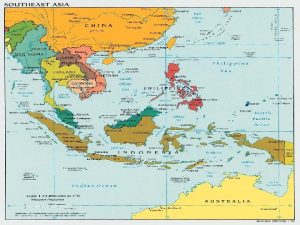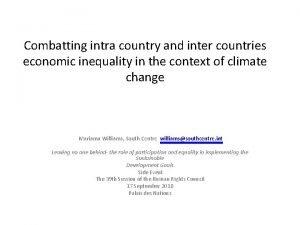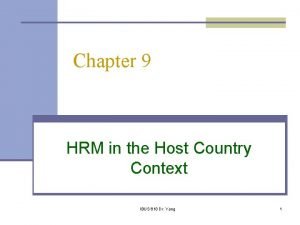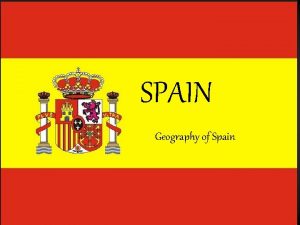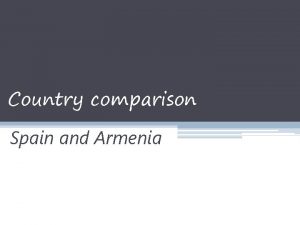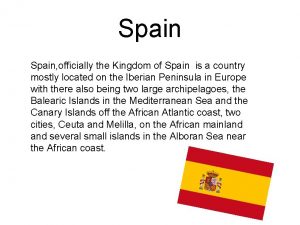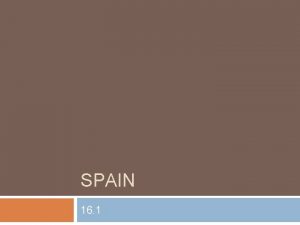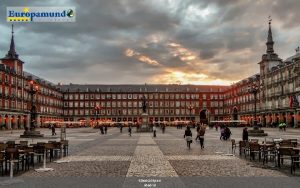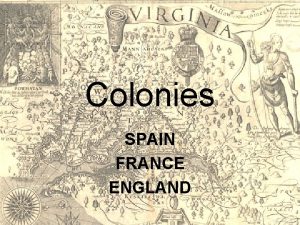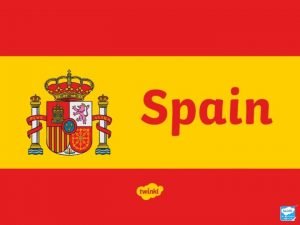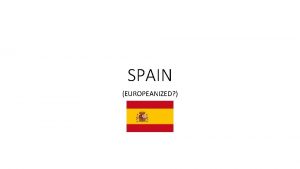SPAIN The country of my soul Spain officially






















- Slides: 22

SPAIN The country of my soul

Spain, officially the Kingdom of Spain is a country and member state of the European Union located in southwestern Europe on the Iberian Peninsula. Its mainland is bordered to the south and east by the Mediterranean Sea except for a small land boundary with the British Overseas Territory of Gibraltar; to the north by France, Andorra, and the Bay of Biscay; and to the northwest and west by the Atlantic Ocean and Portugal.

CLIMATE The climate in Spain is diverse, being affected by altitude (Spain is the second most mountainous county in Europe), the sea (Mediterranean or Atlantic Ocean) and continental effects (central Spain is in effect in a large land mass). • The Mediterranean climate is characterized by dry and warm summers. • The semiarid climate is located in the southeastern quarter of the country, especially in the region of Murcia and in the Ebro valley. In contrast with the Mediterranean climate, the dry season extends beyond the summer. • The oceanic climate is located in north quarter of the country, especially in the region of Basque Country, Asturias, Cantabria and partly Galicia. In contrary to the Mediterranean climate, winter and summer temperatures are influenced by the ocean, and have no seasonal drought.

LITERATURE Due to historic, geographic and generational diversity, Spanish literature has known a great number of influences and it is very diverse. Miguel de Cervantes is probably Spain's most famous author and his Don Quixote is considered the most emblematic work in the canon of Spanish literature and a founding classic of Western literature.

MUSIC Spanish music is often considered abroad to be synonymous with flamenco, an Andalusian musical genre, which, contrary to popular belief, is not widespread outside that region. Various regional styles of folk music abound in Aragon, Catalonia, Valencia, Castile, the Basque Country, Galicia and Asturias. Pop, rock, hip hop and heavy metal are also popular. In the field of classical music, Spain has produced a number of noted composers such as Isaac Albéniz, Manuel de Falla and Enrique Granados and singers and performers such as Plácido Domingo, José Carreras. In Spain there are over forty professional orchestras, including the Orquestra Simfònica de Barcelona, Orquesta Nacional de España and the Orquesta Sinfónica de Madrid.

ART Artists from Spain have been highly influential in the development of Various European artistic movements. The Moorish heritage in Spain, especially in Andalusia, is still evident today in cities like Córdoba, Seville, and Granada. European influences include Italy, Germany and France, especially during the Baroque and Neoclassical periods.

SPORT Sport in Spain has been dominated by football since the early 20 th century. Real Madrid C. F. and FC Barcelona are two of the most successful football clubs in the world. The country's national football team won the UEFA European Football Championship in 1964 and 2008 and the FIFA World Cup in 2010. Rafael Nadal is the leading Spanish tennis player and has won several Grand Slam titles including the Wimbledon 2010 men's singles. In north Spain, the game of pelota is very popular. Alberto Contador is the leading Spanish cyclist and has won several Grand Tour titles including three Tour de France titles.

CUISINE Spanish cuisine consists of a great variety of dishes which stem from differences in geography, culture and climate. Spanish cuisine reflects the country's deep Mediterranean roots. It is heavily influenced by seafood available from the waters that surround the country. Spain's extensive history with many cultural influences has led to a unique cuisine.

PAMPLONA FESTIVAL The Festival of San Fermin, or the Pamplona Bull Running officially begins at midday on 6 th July every year with the 'chupinazo' which takes place on the balcony of the Casa Consistorial in Pamplona. The actual run stretches from the corral at Santo Domingo where the bulls are kept, to the bullring where they will fight that same afternoon. The length of the run is 825 metres and the average time of the run from start to finish is about three minutes. The streets through the old town which make up the bull run are walled off so the bulls can't escape. Each day six fighting bulls run the route as well as two herds of bullocks. Runners are dressed in white with a red hankerchief around their necks. The bulls and the runners then proceed along the route.

ANDALUSIA Andalusia is the most populous and the second largest in area of the autonomous communities of Spain. The territory is divided into eight provinces: Almería, Cádiz, Córdoba, Granada, Huelva, Jaén, Málaga and Seville. Its capital is the city of Seville. The Andalusian coat of arms shows the figure of Hercules and two lions between the two pillars of Hercules that tradition situates on either side of the Strait of Gibraltar. An inscription below, superimposed on an image of the flag of Andalusia reads Andalucía por sí, para España y la Humanidad ‘Andalusia by herself, for Spain and Humanity’. The official flag of Andalusia consists of three equal horizontal stripes, colored green (symbolizing hope and union), white (symbolizing peace and dialogue), and green respectively.

CLIMATE Andalusia sits at a latitude between 36º and 38º 44' N, in the warmtemperate region. In general, it experiences a Mediterranean climate, with dry summers influenced by the Azores High, but subject to occasional torrential rains and extremely hot temperatures. The average temperature in Andalusia throughout the year is over 16 °C.

FLORA & FAUNA Biogeographically, Andalusia forms part of the Western Mediterranean subregion of the Mediterranean Basin, which falls within the Boreal Kingdom. Five floristic provinces lie, in whole or in part, within Andalusia. The biodiversity of Andalusia extends to its fauna as well. More than 400 of the 630 vertebrate species extant in Spain can be found in Andalusia: the Red-knobbed Coot, the Purple Swamphen and the Greater Flamingo, the Greylag Goose, the Spanish Imperial Eagle the Griffon Vulture, and both the Black and Red Kite.

EDUCATION As throughout Spain, basic education in Andalusia is free and compulsory. Students are required to complete ten years of schooling, and may not leave school before the age of 16, after which students may continue on to a baccalaureate, to intermediate vocational education, to intermediate-level schooling in arts and design, to intermediate sports studies, or to the working world.

MUSIC & ART Andalusia has been the birthplace of many great artists: the classic painters Velázquez and Murillo; the sculptors Juan Martínez Montañés and Alonso Cano; and such modern painters as Daniel Vázquez Díaz and Pablo Picasso. Andrés Segovia helped shape the romantic-modernist approach to classical guitar. The music of Andalusia includes traditional and contemporary music, folk and composed music, and ranges from flamenco to rock. Flamenco, perhaps the most characteristically Andalusian genre of music and dance, originated in the 18 th century, but is based in earlier forms from the region. The influence of the traditional music and dance of the Romani people or Gypsies is particularly clear. The genre embraces distinct vocal, guitar, and dance styles.

CUISINE The Andalusian diet varies, especially between the coast and the interior, but in general is a Mediterranean diet based on olive oil, cereals, legumes, vegetables, fish, dried fruits and nuts, and meat; there is also a great tradition of drinking wine. Fried fish—pescaíto frito—and seafood are common on the coast and also eaten well into the interior under coastal influence. Northern bluefin tuna from the Almadraba areas of the Gulf of Cádiz, prawns from Sanlúcar de Barrameda and Deepwater Rose Shrimp from Huelva are all highly prized. Fishing for the Transparent Goby or Chanquete, a once-popular small fish from Málaga, is now banned because the techniques used to catch them trap too many immature fish of other species.

MALAGA Málaga is a big city, with a population of 568, 507 (in 2010). It is the second most populous city of Andalusia and the sixth largest in Spain. It is situated in the south of Spain. It lies on the Costa del Sol of the Mediterranean Sea, about 100 km east of the Strait of Gibraltar and 130 km on north of Africa. Málaga suffered heavy bombing by Nationalist or Republican air forces and naval units during the Spanish Civil War in 1936. After the war, Malaga and its old haunts of Torremolinos and the rest of the Costa del Sol enjoyed the highest growth of the tourism sector in Spain.

CLIMATE Malaga enjoys a subtropical-Mediterranean climate. It has got warm winters with 17 C in the day time and 7 -8 C at night, since December till February. It is summer eight months a year from April through November.

FLORA & FAUNA There are quite a few natural reserves and protected areas in Malaga, which are great for walks and offer some stunning and breathtaking mountain scenery. From the Torcal de Antequera Natural Area to Montes de Malaga Natural Park, you can experience a wonderful natural setting of waterfalls, streams and the rugged landscape that has lots of character due to erosion. There is a variety of flora and fauna for you to see such as flamingos, which are a common sight and are attracted to the saline lake.

CUISINE Malaga has a typical Mediterranean cuisine. Fish, shrimp and other seafood along with sausage, poultry, olive oil and locally grown vegetables are the main ingredients. Chanquetes is a specialty made with tiny fish, espetos sardines and boquerones in vinegar. Gazpacho is a spicy soup served chilled, made with raw vegetables like tomato, onion, and peppers. Another regional specialty is bull's tail called "Rabo de Toro a la Rondeña".

TOURIST ATTRACTIONS Roman Theatre The Chatedral Sagrario Church The House of the Consulate The Town Hall Santiago Church Malaga Bull. Fighting Ring

CULTURAL EVENTS The Málaga Film Festival The August Malaga Fair The Holy Week Celebration The Fiesta Mayor de Verdiales Fiestas de Carnaval

GRACIAS 22 ‘Mircea Eliade’ Team
 The group of people who officially control a country
The group of people who officially control a country Countries near philippines
Countries near philippines The turning point of the civil war
The turning point of the civil war Intra country vs inter country
Intra country vs inter country Host country and home country
Host country and home country Tư thế ngồi viết
Tư thế ngồi viết Thế nào là mạng điện lắp đặt kiểu nổi
Thế nào là mạng điện lắp đặt kiểu nổi Cái miệng nó xinh thế
Cái miệng nó xinh thế Các châu lục và đại dương trên thế giới
Các châu lục và đại dương trên thế giới Cách giải mật thư tọa độ
Cách giải mật thư tọa độ Bổ thể
Bổ thể Tư thế ngồi viết
Tư thế ngồi viết Ví dụ về giọng cùng tên
Ví dụ về giọng cùng tên Thẻ vin
Thẻ vin Thể thơ truyền thống
Thể thơ truyền thống Chúa yêu trần thế
Chúa yêu trần thế Sự nuôi và dạy con của hươu
Sự nuôi và dạy con của hươu Diễn thế sinh thái là
Diễn thế sinh thái là Vẽ hình chiếu vuông góc của vật thể sau
Vẽ hình chiếu vuông góc của vật thể sau Làm thế nào để 102-1=99
Làm thế nào để 102-1=99 Tỉ lệ cơ thể trẻ em
Tỉ lệ cơ thể trẻ em Lời thề hippocrates
Lời thề hippocrates Vẽ hình chiếu đứng bằng cạnh của vật thể
Vẽ hình chiếu đứng bằng cạnh của vật thể

